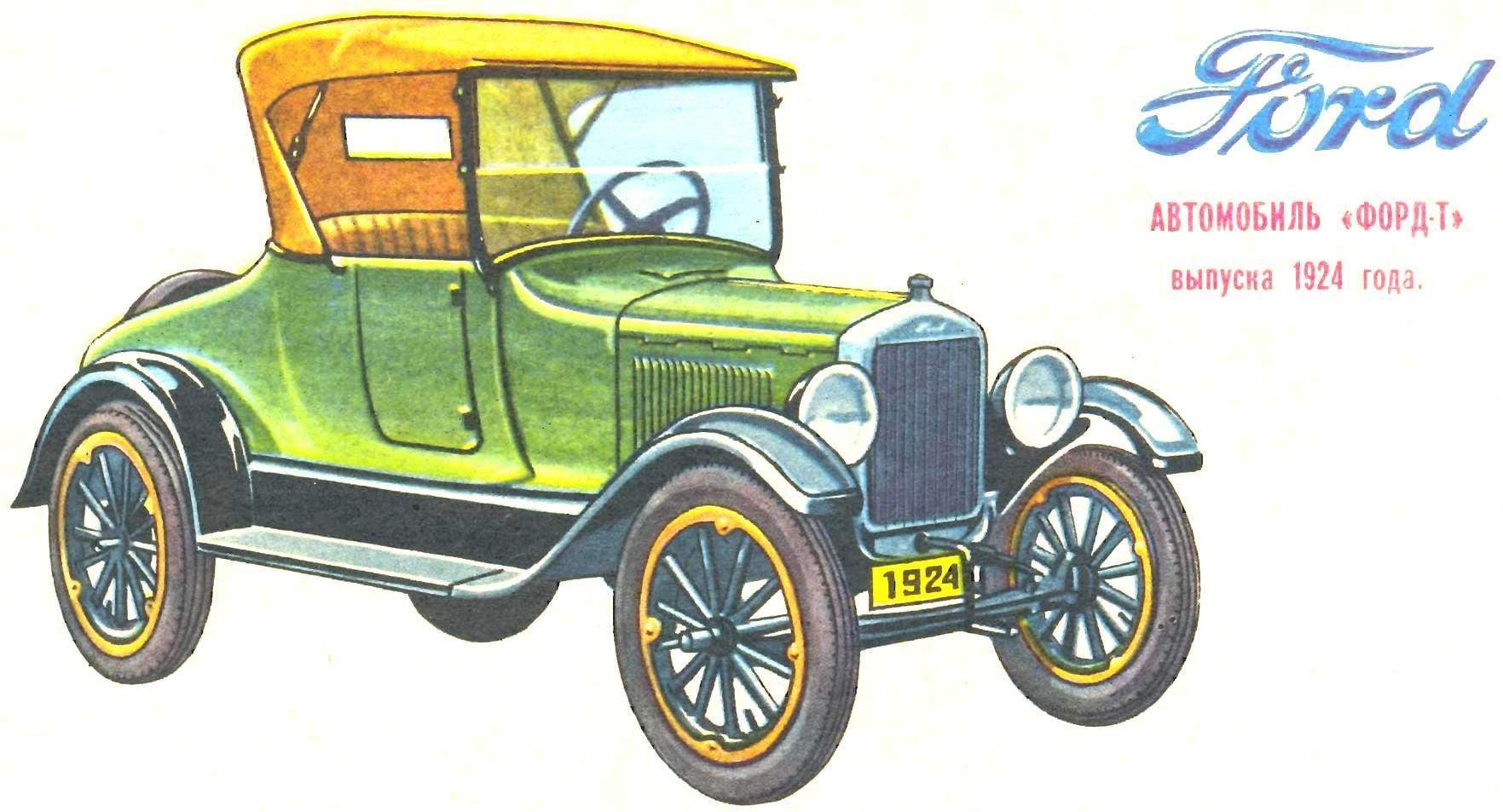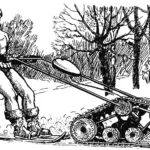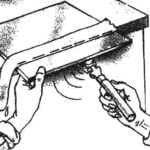 Nickname firmly entrenched behind the “Ford-T” — auto, “copies” which for two decades was 15 007 003 instance. This amazing car deserves to be told separately. Thanks to her Henry Ford became “road king”, and millions of Americans turned from pedestrians to motorists. “Ford-T” was the first in the world began to assemble on the conveyor, it has spawned countless anecdotes and legends, and historians of motoring has got a rich material for research.
Nickname firmly entrenched behind the “Ford-T” — auto, “copies” which for two decades was 15 007 003 instance. This amazing car deserves to be told separately. Thanks to her Henry Ford became “road king”, and millions of Americans turned from pedestrians to motorists. “Ford-T” was the first in the world began to assemble on the conveyor, it has spawned countless anecdotes and legends, and historians of motoring has got a rich material for research.
Henry Ford was not a philanthropist, but she asserted passionately that his goal is to give Americans a simple and cheap vehicle. He was a typical entrepreneur, energetic and shrewd, ruthless mercenary. Ford realized that in such a rapidly developing industrial country like the United States having large expanses of a new vehicle — the car will find wide application. Founded in 1903 the company for the production of horseless carriages, unknown hitherto mechanic showed exceptional qualities of the organizer. His company became famous in the country, but one day, millions of Americans learned that Ford ceases to manufacture several исг1ытанных I enjoyed good demand models and brings your plant to produce a single car. It was the “Ford-T”.
From the outset the designers have created a car, the most adapted for mass production, cheap to manufacture and therefore affordable. He was easy to operate and repair, has a good passing ability, wide application versatility — not without intention on the emblem of the cars of early releases of the brand were the words “the universal car” (the universal car). The success of the car and provide intelligent advertising, and developed a network of points of sales and service, and well-established conveyor production system.
It is wrong to see everything only the merit of the Ford. He certainly was a skilled organizer, but worked with him hundreds of men, W”th the talent and energy Ford cleverly used. He did not, and, Willis played a leading role in the design of a machine. An elaborate system of mass production “king of cars” must engineers I. Sorensen, V. Knudsen, CH., Flinders. And does not Mr. Ford first proposed to assemble cars on the Assembly line. This idea advanced To – Avery is a specialist in the field of equipment and machines. Together with engineer W. Lannom he came to the conclusion that “installation on the go” — his own expression — will help to accelerate to reduce the cost of production of cars” Ford quickly realized what enormous profits promises offer two engineers, and supported him. “Installation on the go” a prototype was tested in August 1913 and January 1914 Assembly “Ford” is fully transferred to the conveyor.

But, in order to provide the pipeline with the necessary amount of details needed high-performance machines. American firms while such cars were not allowed. And then something appeared on the stage of K. end, one of Ford’s engineers, the designer of many special machines that created, for example, multi-spindle drilling machines used in machining of cylinder blocks.
Ford skillfully picked up people coordinated their actions, maximize their opportunities and then… get rid of them. So went to a competitive firm “Chevrolet” V. Knud-sen, left Ford and came to the factory “Chrysler”, Willis, broke up with the former owner of the Dodge brothers who supplied from 1903 to 1913 the engines and other components. It is not surprising that in automotive history, their names can be found by chance, all the merit attributed to “the boss”.
But let us return to the main hero of our story, the car “Ford-T”. The first models of this car came out of the factory in October 1908. What were they interesting? First and foremost, smart design, Here found a wide application of alloy steel. Impurities of vanadium significantly increase its strength, which in turn gave the opportunity to make many parts are lighter than on other machines.
In the interest of reducing weight for the gear box and steering gear ideas Wills used planetary gearboxes, compact whiter than common reducers with fixed bearings of the shafts. In the end, “Ford-T” weighed 880 kg — considerably less than other machines of the same dimensions and power.
Ford engineers have carefully studied the experience of the company “Cadillac” which in those years became widely implement interchangeability of parts. Manufactured with tight tolerances, the parts fit to any machine of this model without any adjustment.
From progressive design features should be noted left-sided location of the steering wheel, a detachable cylinder head (at this step then very few designers dared), four cylinders, cast in a single unit (not in pairs), and combined in a common Assembly with the motor gearbox.
It is impossible to ignore the simplicity of the device of the engine. It lacked water and oil pumps water circulated in the cooling system due to the difference in temperature, and lubrication was carried out by spraying.
In order to simplify and reduce the cost of the car designers have abandoned the mechanism for adjusting engine valves have made fixed wheels (just removed the tire, I later rims) finally, the body had a simplified design, which, by the way, I brought to life the disparaging nickname “tin Lizzie”.

“Ford-T” in 1913 with a body “Roadster”

Delivery van chassis “Ford-T”

Body two-door “Tudor” in 1915 on the chassis “Ford-T”.

“Tudor” “Ford-T”, 1927
For suspension he served two transverse leaf springs, frame rails but entire length had a constant profile. The fuel flowed to the carburetor by gravity (fuel pump missing) of the cylindrical tank positioned under the seat.
“Ford-T” was markedly different from the classic designs of those years and stood out for the originality of the devices in many nodes. For example, its transmission was a planetary — axles and gears, in addition to the rotation, made a circular motion. This unusual transmission provided two forward gears and one back, and for their inclusion served two pedals and a lever.
Magneto was a 16 horseshoe-shaped magnets mounted on the flywheel of the engine, and coils 16 mounted against them inside the case. The magnets spinning with the flywheel, “bathed” in oil and stirred in coils low voltage. For voltage conversion served as a bulky box of coils and electromagnetic circuit breakers.
The controls on the “Lizzie” was located not as on the machines of other brands. Therefore, for driving needed a special skill. Thus, the role familiar to many drivers of those years, the gas pedal did a little lever on the right side of the waters of the steering column.
But though unusual in design was the nodes Lizzie, removal and repair were simple, and follow these .work could most unskilled people in primitive workshops.
Different “Ford-T” I an enviable throughput, which greatly contributed to the truly great ground clearance (250 mm) wheels with tires of large diameter (about 780 mm) and highly flexible engine performance. It is no wonder that these cars became very popular in the army. The Russian army during the first world war, bought a large batch of “Ford-T”, and a lot of these machines went to the red Army, by the Way, one of them faithfully served the legendary division commander V. I. Chapaev. Driving a “tin Lizzie” converted ” a sanitation truck, traveled hundreds of miles on military roads, and Ernest Hemingway.
What indicators were characteristic of “Ford-T”? The engine with working volume 2893 cm3 developed capacity of 22.5 HP at 1800 rpm, depending on the type of the body weight ranged from 788 to 906 kg. With a standard gear ratio of main gear to 3.67 speed was 65-70 km/h on a “fast” reducers rear axle with gear ratios of 2.75 and 3.0 can provide a maximum speed of respectively 96 and 104 km/h. However, with them the machine was not able to take a little bit steep.
Consumption of gasoline (according to the national test run of 1912) an average of 11 liters per 100 km. According to this mileage, in heavy traffic conditions on the fords were often damaged candles. And on steep climbs stopped the engine because it is located under the driver’s seat the gas tank where the fuel received by gravity to the engine, below the carb.
I must say that compared to the fuel consumption of the petrol tank could hold quite a lot of fuel — 45 L. That is stock enough for about 440— 450km important fact for America of the second decade of the twentieth century, when gas stations are still rare on the roads.
The car had a kind of “traits”, which were well played out in the comic films of Chaplin. Thus, with the charging handle in cold weather when the oil in the transmission was still thick, the engine is not fully separated from transmission and “Ford-T” strove to knock down its owner. In the first moments of startup of the engine, usually “caught” not all cylinders, but three, or even two. The fourth came into work with 2 — 3 second delay, not surprisingly, in those 2-3 seconds the car was shaking feverishly.

When, in 1919, on the “Ford-T” was the electric lights, they have received the current from the windings of the low tension magneto. At low engine speeds (slow drive in the fog or dirt) the light was failing, and blinking. In short, the “Ford-T” had many shortcomings.
At the same time “Ford-T” had a reputation of a very reliable and hardy car. In June 1909, one of them, participating in the Transamerica tour from new York to Seattle, the first has finished the race in 22 days On hours and 52 minutes. I must say that in those days the “heartland” of the United States were famous for their roads (even in 1925 from 3 million km of roads, only the sixth part was solid . coating), and, according to many experts, precisely because of the “Ford-T” America sat on the car.
Obviously, in the early model years of this machine the way it was. But the technique went forward, improved roads, varied tastes and demands of customers. But Ford, in an effort to invest in the production of excess, in his opinion, money, stubbornly kept the previous design and said that “any customer can order any color of car provided that it’s black”. As a result, by the mid 20-ies of sales “Ford” began to fall.
The palm went to the car “Chevrolet”.
Well staged is not saved the situation. I had to reluctantly agree on the colour of the cars in different colors and even introduce some improvements into the design. Cars received electric starter and interior lights, gas tank moved from under the seat under the engine hood, the shape of the radiator instead of angular became rounded, changed the tire size (29″-4,40″ instead of 30″-3,50″) increased from 406 to 432 mm diameter handlebar. At the same time by 39 mm lowered the frame relative to the wheels and the wings and the body gave a more modern form. But in vain.
Nothing could save the doomed car, and in may 1927, its production has ceased.
Our tab is “Ford T” with double open-top Roadster — it is in the US called “Rane-baut”. In 1922, Lizzie with this body weighed 844 lbs. In the back of the “Roadster” was a trunk with a capacity of 0.12 m3 (as in the old model of “Zaporozhets”), then such a trunk is considered roomy. Double closed body coupe on the same chassis weighed as much.. his trunk was larger — volume of 0.18 m3. But quadruple a closed two-door “Ford-T” (it was called “Tudor”) already weighed 895 kg and this is the same, but four-door (“fordor”) — all Easier 906 kg (790 kg) was the car with the open four-seater body, which the Americans called “Touring”. The last three modifications do not have a trunk.
In addition, on the chassis “Ford-T” was issued “pickup”, weighed 788 kg.
For completeness we should call solid truck “Ford-T”, chassis, which differed from the passenger extended with up to 2540 3150 m base, a worm gear (not spiral bevel gears) rear axle, larger tires (32″-4,50″) and a speed of 35 km/h. This truck transformed into a bus, van, carriage, ambulance and fire truck.

The driver of the car “Ford-T”, edition of 1924:
1 — the lever of the ignition timing, 2 — horn button, 3 — the lever of a permanent gas, 4 — lock of ignition, 5 — ammeter 6 — lamp lighting devices, 7 — button choke carb (“choke”), 8 — steering wheel 9 — the lever of a manual brake, 10-g of the clutch pedal, 11 pedal reversing, 12 — brakes 13 — speedometer.
Yes, and the cars “Ford-T” was often subjected to various alterations. Many owners wanted to modernize structurally decrepit Lizzie. And that for them is a different company (not Ford plants!) provided a market for special components and sets of components: two speed rear axle, front wheel brakes, wheel tangentyere wire spokes, the prefix to the transmission, allowing you to get three or four gears, and even a set of nodes that are allowed to do the leading and the front wheels.
To improve speed performance, buyers are offered a special camshafts, enlarged valves, race double of the body. All these tricks were possible to raise the engine power, reduce aerodynamic losses and gear ratio main gear of 2.57 was given the opportunity to develop a speed of 110-115 km/h.
Ford, of course, was not so interested in the motorization of America as in personal enrichment through the motorization. Net profit in the amount of $ 100 million received in 1925, justified all the tricks. And yet, although by the end of 1926, the proportion of Ford’s cars in the car Park of the United States was 30 percent, although at this time, 16 plants beyond the borders of America relentlessly stamped “tin Lizzie” automobile king had to capitulate to the demands of the time.
Since then, Ford lost its leading position in the field of car production. Next came mark Chevrolet, part of the Corporation “General motors”, which today continues to hold the superiority in the number of cars, “fords” have since moved into second place.
RECOMMENDATIONS FOR MODELING
It is very important for proper transfer of the image machine to perform accurately its characteristic elements. For “Ford-T”, has in General a very ordinary appearance, should be carefully obey the steering wheel, which on open models (in particular, the “Roadster”) is striking. Note that under the curved-down knitting “donut” is a “round box” — the planetary reducer of the steering mechanism and two lever (ignition advance on the left and gas on the right).
Shown in the figure and drawings the sample of the machine refers to the beginning of 20-ies, that is, to the time already used electric lighting (don’t forget about the shape of the headlights), the signal (the button on the steering column on the left side) and starter. It is characterized by a cover on the cowling in front of windshield. But it’s not a ventilation hatch, appears at first glance: under the hood lies the tube of the fuel tank.
Windscreen for Lizzie with open bodies (even in upgraded variants) consisted of two horizontal pivoting parts. At the closed body glass did solid. Don’t forget about the wiper, which on later models was required.
It is important to thoroughly implement wooden wheels — each with 12 spokes are oval in cross section. The later models were already detachable rims, which were actually attached to the wheel by four bolts.
Of course, the front should be the starting handle, well , familiar in the movies, where Charlie Chaplin fought with indomitable Lizzie.
Nickel-plated parts with “Ford-T” was a bit: radiator, headlight rims, door handles, radiator cap, hub caps. In recent years, the existence of this machine, the body is painted not only in black but also in grey, green, brown, blue, brown.



